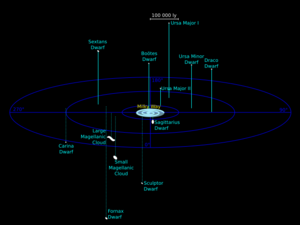Satellite galaxy facts for kids

A satellite galaxy is like a smaller space city that orbits a much larger and brighter space city, called a host galaxy. Think of how the Earth orbits the Sun in our Solar System. Satellite galaxies are held close to their host galaxy by a strong pull called gravity.
Most satellite galaxies are dwarf galaxies, meaning they are quite small. But some satellites of huge galaxy clusters can be very big! Our own Milky Way galaxy has about fifty satellite galaxies orbiting it. The biggest one is called the Large Magellanic Cloud.
Satellite galaxies are not the only things that orbit bigger galaxies. There are also globular clusters. These are tight groups of stars. But satellite galaxies are different from globular clusters. Satellite galaxies are much bigger and more spread out. They also have a lot of invisible stuff called dark matter around them. This dark matter helps explain how stars move inside them.
What Happens to Satellite Galaxies?
Satellite galaxies often have a tough time. They are always interacting with their big host galaxy and other satellites. These interactions can change them a lot.
Losing Gas and Stars
The big host galaxy can pull gas and stars away from its satellites. This happens because of two main forces:
- Tidal forces: This is like the Moon's gravity pulling on Earth's oceans. The host galaxy's gravity can stretch and pull parts of the satellite galaxy away.
- Ram pressure stripping: Imagine a car driving through rain. The rain hits the car. When a satellite galaxy moves through the gas around its host galaxy, this gas can push away the satellite's own gas.
When a satellite galaxy loses its gas, it can't make new stars anymore. This means it becomes "quiescent," or quiet, because star formation stops.
Galaxy Mergers
Sometimes, satellite galaxies can even crash into their host galaxy. This is called a minor merger because one galaxy is much smaller than the other.
Satellites can also crash into each other. If two galaxies of similar size crash, it's called a major merger.
Even though galaxies are huge, they are mostly empty space. So, when galaxies merge, stars usually don't crash into each other. Instead, the galaxies pass through each other. Their gravity pulls and stretches them. Over time, they mix together to form one much bigger galaxy.
Scientists study how often these mergers happen. This helps them understand how giant groups and clusters of galaxies form in the universe.
See also
 In Spanish: Galaxia satélite para niños
In Spanish: Galaxia satélite para niños
- Dwarf galaxy
- Dwarf spheroidal galaxy
- Dwarf elliptical galaxy
- Galaxy merger
- Orbital decay
- Tidal stripping
- Hubble sequence
- Starburst galaxy
- Galactic tide
- Interacting galaxy
- Satellite galaxies of the Milky Way
- Satellite galaxies of Andromeda
- Ram pressure

